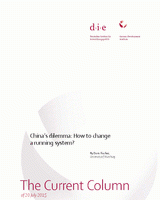China’s dilemma: How to change a running system?
Fischer, DorisThe Current Column (2015)
Bonn: German Development Institute / Deutsches Institut für Entwicklungspolitik (DIE) (The Current Column of 20 July 2015)
Bonn, Würzburg, 20 July 2015. If the Greek crisis was aggravated by a new government that rejected bold market-oriented reforms after coming into office in January 2015, the recent turbulences at the Chinese stock markets were in contrast triggered by too bold market-oriented reforms. In both cases the repercussions will be felt for a long time.
For years, Chinese and foreign economists have stressed that China needs a new growth model as the export- and investment-driven model has become unsustainable. Hence, Chinese as well as foreign investors have hoped for institutional reforms, namely market-oriented reforms, after the Wen Jiabao and Hu Jintao reign (2003-2013) had led to a stronger role for the state in the economy.
Against this background, experts thoroughly analysed the personnel tableau of the new Beijing leadership that emerged from the 18th Party Congress in 2012 and the National People’s Congress in 2013. This “Pekinology” was important to get a hint regarding the economic policy intentions of the new leadership. The overall tableau looked mixed with regard to the headcount of market-oriented reformers and state capitalists. However experts agreed that reformers – many of them with strong expertise and international reputation – dominated positions relevant for the financial and fiscal sector. As a consequence, reforms were expected to be most ambitious in these arenas.
This expectation was confirmed by a policy agenda defined in late 2013 as well as the push for the Shanghai Free Trade Zone, accelerated Renminbi internationalisation and – eventually – the liberalization of the stock exchanges in Shanghai and Shenzhen. While policy initiatives regarding other economic issues were hardly market-oriented (for example the merger of large state-owned enterprises - SOE), those for the financial sector were rather ambitious.
However, right from the start, the case of the reformers was challenged by two problems: First, China’s GDP growth has been decelerating. Consequently, Party Secretary Xi Jinping introduced the mantra of the “New Normal”. It stated that “quality” of growth” is more important than quantity, and that lower growth rates are anyway to be expected at this stage of China’s development. Unfortunately, the leadership did not buy into its own message. Instead, by 2015 it started to promise seven percent annual growth, showing the leadership’s nervousness about the implications of the “New Normal”. Second, recent reforms have been accompanied by a ferocious campaign against corruption. Of course anti-corruption policies can support economic reforms.
However, the way the campaign was staged as a Party initiative suffocated economic initiative and contributed to lower economic confidence and growth.
In this situation, the market-oriented reformers somehow convinced the rest of the leadership that thriving financial markets could solve a number of economic problems: SOE debts, weak private enterprise investment and weaker than expected consumer demand. In order to push reforms, the reformers made a daring bet on the ability of financial markets to lead economic development, and they probably faced strong headwinds from the very beginning.
The strategy showed first flaws in early 2015: Whenever the financial markets slowed in their upward trend, government and party media stressed that the bullish market development was to last. These prophecies seemingly supported financial sector development but actually endangered the market-oriented reforms as they encouraged people to bet on future surges of the market driven by government backing. When the bubble finally burst this year in June and July, the idea of driving market-oriented reforms via the financial sector collapsed within days. The government recurred to massive market interventions to stabilize the stock markets in Shanghai and Shenzhen.
Much has been written about the loss of money of small private investors due to the market turmoil and the loss of confidence in the Chinese government’s market-oriented reform drive. Important as both aspects are, the real tragedy is that the reformers have lost face and influence within the government elite. Imagine for a moment, that “Pekinology” was right in 2013 and that the reformists within the new leadership really hoped to trigger wider market reforms by reforming the financial sector first. In this case they failed dramatically, not only in the eyes of the Chinese public and international markets, but even more so in the eyes of their opponents within the Chinese government.
The question arises who credibly could change the current economic system and move China to a new growth model? Unfortunately, the recent developments in China support those people in the Chinese government who are convinced that one should never change a (still) running system. At least for the foreseeable future, reformers in the leadership will face difficulties in pushing for further bold market-oriented reforms, be it within or outside the financial sector.
Doris Fischer, Chair China Business and Economics, University of Würzburg
